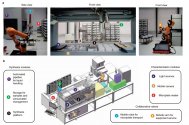Chinese scientists made progress in sodium-based battery. International reviewers of the work ranked it as a top 5% "very important paper".
Paper in English:
Ultrathin CuF2-Rich Solid-Electrolyte Interphase Induced by Cation-Tailored Double Electrical Layer toward Durable Sodium Storage
Abstract
Solid-electrolyte interphase (SEI) seriously affects battery's cycling life, especially for high-capacity anode due to excessive electrolyte decomposition from particle fracture. Herein, we report an ultrathin SEI (3–4 nm) induced by Cu+-tailored double electrical layer (EDL) to suppress electrolyte consumption and enhance cycling stability of CuS anode in sodium-ion batteries. Unique EDL with SO3CF3-Cu complex absorbing on CuS in NaSO3CF3/diglyme electrolyte is demonstrated by in situ surface-enhanced Raman,
Cyro-TEM and theoretical calculation, in which SO3CF3-Cu could be reduced to CuF2-rich SEI. Dispersed CuF2 and F-containing compound can provide good interfacial contact for formation of ultrathin and stable SEI film to minimize electrolyte consumption and reduce activation energy of Na+ transport. As a result, the modified CuS delivers high capacity of 402.8 mAh g−1 after 7000 cycles without capacity decay. The insights of SEI construction pave a way for high-stability electrode.
News story in Chinese:
郑州大学在钠离子电池界面调控研究方面取得积极进展
近日,郑州大学化学学院能源化学研究所在钠离子电池阳离子调控界面领域取得积极进展,在国际重要顶级期刊《Angewandte Chemie International Edition》发表题为“Ultrathin CuF2-Rich Solid-Electrolyte Interphase Induced by Cation-Tailored Double Electrical Layer toward Durable Sodium Storage”的原创性研究论文,该项工作得到了国际同行的高度认可,被评审专家选为期刊Top 5% 的Very Important Paper(VIP论文),论文的第一作者为博士研究生宋轲铭,论文通讯作者为陈卫华教授,郑州大学化学学院为第一单位和通讯单位。
钠离子电池因资源丰富、价格低等优点成为规模储能领域最具潜力的电池体系之一,部分具有大规模应用潜力的重要正、负极材料正在走向产业化进程。然而,具有长循环性能的高容量负极仍然是一个很大的挑战。其中,CuS、NiS、FeS2等转化型金属硫化物因其丰富的无毒元素而备受关注。然而其循环过程中由于颗粒破碎不断形成厚的固态电解质界面膜(SEI)导致电解液过度消耗和电极的高极化,进而造成负极容量不断损失。因此,高容量负极的SEI设计对于长寿命电池仍是挑战性难题。陈卫华教授研究团队通过Cu+调控的双电层在CuS负极表面实现了超薄SEI(3-4 nm)构建,抑制电解液分解提升钠离子电池的循环稳定性。铜集流体在NaSO3CF3/二乙二醇二甲醚(DGM)电解液中溶解出微量Cu+,在CuS负极的双电层中,SO3CF3-Cu吸附在电极表面,进一步还原形成富CuF2的SEI。分散的CuF2和含氟化合物具有良好的界面接触,导致超薄稳定的SEI,降低钠离子传输活化能提高扩散速率。修饰的CuS循环7000周容量无衰减。该工作为解决高容量负极材料容量衰减的问题提供了一种新策略。
此外,陈卫华教授团队2021年在钠离子电池界面调控研究方面提出了界面催化策略诱导快速形成完整的二维超薄SEI机制,设计了一种FeS2纳米簇嵌入N, S掺杂碳骨架的负极材料,材料表面以点阵形式分布的Fe-N-C/Fe-S-C键作为众多催化中心催化电解质溶液分解,FeS2纳米簇作为晶核,诱导形成完整的、二维超薄SEI膜,获得超高首周库伦效率(~92%)、超长循环稳定性(10000周容量保持92.7%),低温下性能(-15oC)和高速钠存储动力学。(Angew. Chem. Int. Ed.2021,60, 11481,入选Wiley-VCH Hot Topic: Surfaces and Interfaces,ESI高被引论文)。
这些研究得到了国家自然科学基金、河南省省级科技研发计划联合基金项目和郑州大学的资助。

